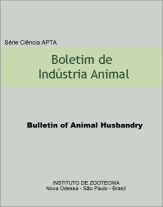SOYBEAN AND FORAGE PRODUCTION IN INTEGRATED CROP-LIVESTOCK SYSTEMS
DOI:
https://doi.org/10.17523/bia.v74n3p229Keywords:
forage farming, integrated systems, summer forage species, winter forage species.Abstract
The objective of this study was to evaluate the production of tropical and winter forage species and soybean production in an integrated crop-livestock system. The following treatments were applied: T1, overseeding of millet + seeding of oat FMS-1; T2, overseeding of millet + direct seeding of oat IPR-126; T3, overseeding of millet + direct seeding of oat IPR-61; T4, overseeding of Tanzania grass (Panicum maximum) + overseeding of Brachiaria ruziziensis; T5, direct seeding of sorghum + Brachiaria ruziziensis. The experimental units consisted of 1.5-ha pastures allocated in a completely randomized design with two replicates. The variables measured were forage production, forage mass, soybean production, and forage residue in direct seeding. In all cuts, forage mass was higher in paddocks with Brachiaria ruziziensis compared to the other treatments, especially Brachiaria ruziziensis with Tanzania grass. The higher forage mass was a consequence of the higher forage production observed in these paddocks. This result shows that tropical grasses could be an alternative to cool-season grasses for winter pasture. On the other hand, no significant difference in soybean production was observed between the strategies used. However, the higher long-term deposition of organic matter in soil resulting from the greater forage mass may contribute to increase productivity. In conclusion, intercropping of Tanzania grass with Brachiaria ruziziensis in integrated crop-livestock systems appears to be an alternative that provides high grain and forage productivity.Downloads
Downloads
Published
Issue
Section
License
Os autores não serão remunerados pela publicação de trabalhos, pois devem abrir mão de seus direitos autorais em favor deste periódico. Por outro lado, os autores ficam autorizados a publicar seus artigos, simultaneamente, em repositórios da instituição de sua origem, desde que citada a fonte da publicação original seja Boletim de Indústria Animal. A revista se reserva o direito de efetuar, nos originais, alterações de ordem normativa, ortográfica e gramatical, com vistas a manter o padrão culto da língua e a credibilidade do veículo. Respeitará, no entanto, o estilo de escrever dos autores. Alterações, correções ou sugestões de ordem conceitual serão encaminhadas aos autores, quando necessário. Nesses casos, os artigos, depois de adequados, deverão ser submetidos a nova apreciação. As opiniões emitidas pelos autores dos artigos são de sua exclusiva responsabilidade. Todo o conteúdo deste periódico, exceto onde está identificado, está licenciado sob a Licença Creative Commons Attribution (CC-BY-NC). A condição BY implica que os licenciados podem copiar, distribuir, exibir e executar a obra e fazer trabalhos derivados com base em que só se dão o autor ou licenciante os créditos na forma especificada por estes. A cláusula NC significa que os licenciados podem copiar, distribuir, exibir e executar a obra e fazer trabalhos derivados com base apenas para fins não comerciais.













